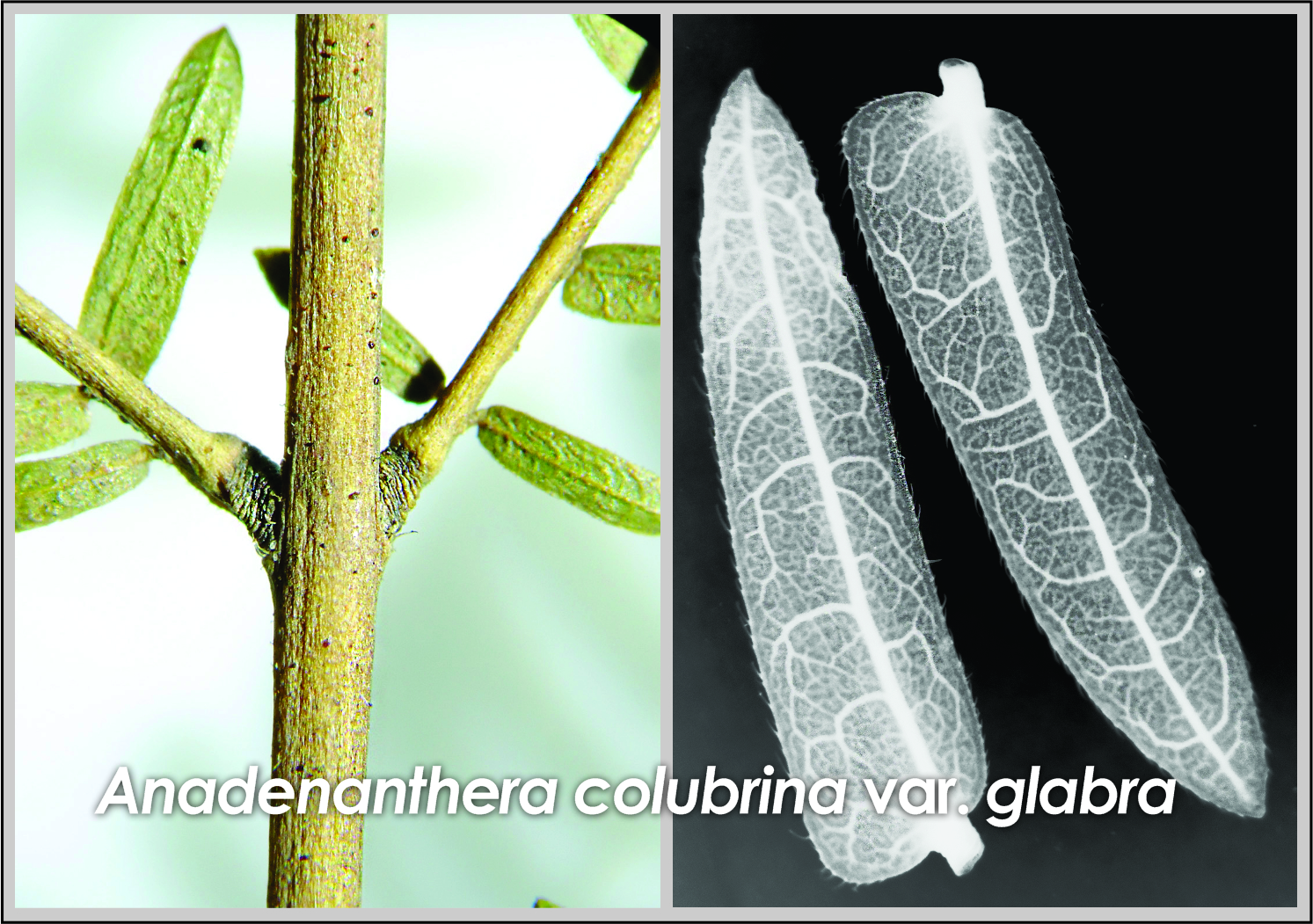A new variety of Anadenanthera colubrina (Leguminosae, Mimosoideae) from Argentina
DOI:
https://doi.org/10.31055/1851.2372.v55.n3.27348Keywords:
Anadenanthera, Argentina, Fabaceae, Leguminosae, Mimosoideae, taxonomyAbstract
Backgrounds and aims: The genus Anadenanthera is represented in Argentina by a single species, A. colubrina, with two varieties known so far, var. cebil and var. colubrina. These varieties can be clearly distinguished by the venation pattern of the leaflets. In this work, a third variety, var. glabra, is here circumscribed by a combination of characters of its leaves and bark.
M&M: Specimens at CTES and MCNS were studied, and field observations were performed in Argentinean natural environments. The specimens were analyzed morphologically with optical and scanning electron microscopies.
Results: The new variety glabra differs from varieties cebil and colubrina, by its stems without mamelons, leaves with rachis glabrous on both surfaces or only on the abaxial surface, and leaflets with a reticulated, closed and complex venation. An illustration, photographs, a morphological comparative table and a key to the varieties, and a distribution map are provided.
Conclusions: The three varieties of Anadenanthera colubrina, var. cebil, var. colubrina and var. glabra, inhabit the Seasonally Dry Neotropical Forests of northern Argentina, showing the new variety a restricted distribution to the northeastern region of the country.
References
ALTSCHUL, S. von R. 1964. A taxonomic study of the genus Anandenanthera. Contrib. Gray Herb. Harvard Univ. 193: 1-65.
BFG (The Brazil Flora Group). 2015. Growing knowledge: an overview of Seed Plant diversity in Brazil. Rodriguésia 66: 1085-1113.
BURKART, A. 1987. Anadenanthera Speg. En: BURKART, A. (ed.), Flora Ilustrada de Entre Ríos. Colec. Cient. Inst. Nac. Tecnol. Agropec. 6: 481-482.
CACCAVARI, M. A. 2002. Pollen morphology and structure of Tropical and Subtropical American genera of the Piptadenia group (Leguminosae: Mimosoideae). Grana 41: 130-141.
http://dx.doi.org/10.1080/001731302321042597
CIALDELLA, A. M. 2000. Fabaceae. Mismosoideae. Mimoseae: Anadenanthera, Piptadenia, Parapiptadenia. En: HUNZIKER, A. T. (ed.), Fl. Fanerog. Argent. 67: 1-10.
DE QUEIROZ, L. P. 2009. Leguminosas da Caatinga. Universidade Estadual de Feira de Santana, Feira de Santana.
DIGILIO, A. P. L. & P. R. LEGNAME. 1966. Los árboles indígenas de la Provincia de Tucumán. Opera Lilloana 15: 1-283.
DRYFLOR (Latin American and Caribbean Seasonally Dry Tropical Forest Floristic Network). 2016. Plant diversity patterns and their conservation implications in Neotropical dry forests. Science 353: 1383-1387. https://doi.org/10.1126/science.aaf5080
GONCALVES, A. L., M. V. GARCIA, M. HEUERTZ & S. C. GONZALEZ-MARTINEZ. 2019. Demographic history and spatial genetic structure in a remnant population of the subtropical tree Anadenanthera colubrina var. cebil (Griseb.) Altschul (Fabaceae). Ann. For. Sci. 76: 1-18. https://doi.org/10.1007/s13595-019-0797-z
LEWIS, G. P. 2008. Anadenanthera Speg. En: ZULOAGA, F. O., O. MORRONE & M. J. BELGRANO (eds.), Catálogo de las Plantas Vasculares del Cono Sur (Argentina, Sur de Brasil, Chile, Paraguay y Uruguay). Monogr. Syst. Bot. Missouri Bot. 107: 2114.
LEWIS, G. P., B. D. SCHRIRE, B. A. MACKINDER & M. LOCK. 2005. Legumes of the world. Royal Botanic Gardens, Kew, London. https://doi.org/10.1111/1467-8748.00116
LPWG (The Legume Phylogeny Working Group). 2013a. Legume phylogeny and classification in the 21st Century: progress, prospects and lessons for other species-rich clades. Taxon 62: 217-248.
https://doi.org/10.5167/uzh-78167
LPWG (The Legume Phylogeny Working Group). 2013b. Towards a new classification system for legumes: Progress report from the 6th International Legume Conference. S. African J. Bot. 89: 3-9. https://doi.org/10.1016/j.sajb.2013.07.022
LPWG (The Legume Phylogeny Working Group). 2017. A new subfamily classification of the Leguminosae based on a taxonomically comprehensive phylogeny. Taxon 66: 44-77.
https://doi.org/10.12705/661.3
MARTÍNEZ, O. G., M. E. BARRANDEGUY, M. V. GARCÍA, D. A. CACHARANI & D. E. PRADO. 2013. Presencia de Anadenanthera colubrina var. colubrina (Fabaceae, Mimosoideae) en Argentina. Darwiniana nueva serie 1: 279-288. https://doi:10.14522/darwiniana.2013.12.536
MOGNI, V. Y., L. J. OAKLEY & D. E. PRADO. 2015. The distribution of woody legumes in neotropical dry forests: the Pleistocene Arc Theory 20 years on. Edinburgh J. Bot. 72: 35-60.
https://doi:10.1017/S0960428614000298
MORIM, M. P. 2015. Anadenanthera in Lista de Espécies da Flora do Brasil. Jardim Botânico do Rio de Janeiro. http://floradobrasil.jbrj.gov.br/jabot/floradobrasil/FB18071 [acceso: 26 julio 2019].
OAKLEY, L. J. & D. E. PRADO. 2011. El Dominio de los Bosques Secos Estacionales Neotropicales y la presencia del Arco Pleistocénico en la República del Paraguay. Rojasiana 10: 55-75.
PRADO, D. E. & P. E. GIBBS. 1993. Patterns of species distributions in the dry seasonal forests of South America. Ann. Missouri Bot. Gard. 80: 902-927.
PRADO, D. E. 1995. Selva pedemontana: contexto regional y lista florística de un ecosistema en peligro. En: Brown, A. D. & H. R. Grau (eds.), Investigación, conservación y desarrollo en selvas subtropicales de montaña, pp. 19-52, Universidad Nacional de Tucumán, Facultad de Ciencias Naturales e Instituto Miguel Lillo, Horco Molle.
PRADO, D. E. 2000. Seasonally dry forests of tropical South America: from forgotten ecosystems to a new phytogeographic unit. Edinburgh J. Bot. 57: 437-461. https://doi:10.1017/S096042860000041X
QGIS (Quantum GIS Development Team). 2016. Quantum GIS Geographic Information System. Open Source Geospatial Foundation Project. http://qgis.osgeo.org [acceso: 18 mayo 2019].
SALLABANKS, R. & S. P. COURTNEY. 1992. Frugivory, seed predation, and insect-vertebrate interactions. Annu. Rev. Entomol. 37: 377-400. https://doi.org/10.1146/annurev.en.37.010192.002113
THIERS, B. Index Herbariorum: a global directory of public herbaria and associated staff. New York Botanical Garden’s Virtual Herbarium, Disponible en: http://sweetgum.nybg.org/ih [Acceso: 15 noviembre 2018].

Downloads
Published
Issue
Section
License
Copyright (c) 2020 Daniel A. Cacharani, María E. Barrandeguy, María V. García, María L Costas, Olga G. Martínez, Darién E. Prado

This work is licensed under a Creative Commons Attribution-NonCommercial-NoDerivatives 4.0 International License.
Provides immediate and free OPEN ACCESS to its content under the principle of making research freely available to the public, which fosters a greater exchange of global knowledge, allowing authors to maintain their copyright without restrictions.
Material published in Bol. Soc. Argent. Bot. is distributed under a Creative Commons Attribution-NonCommercial-ShareAlike 4.0 International license.




